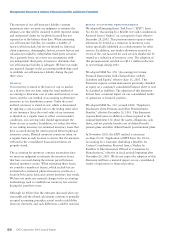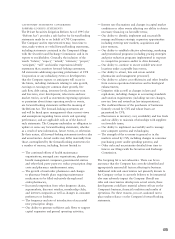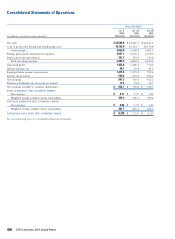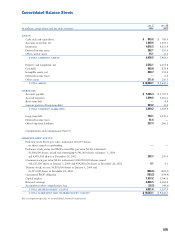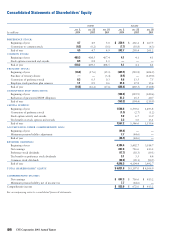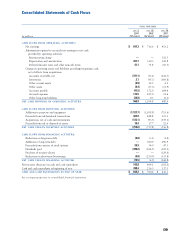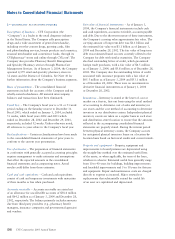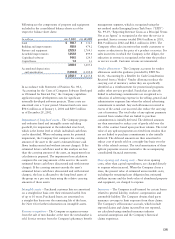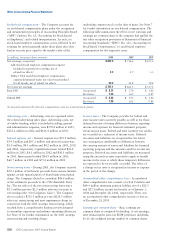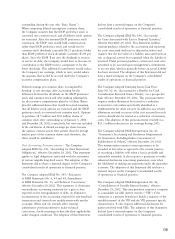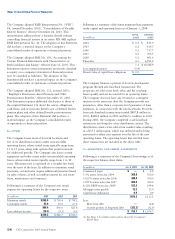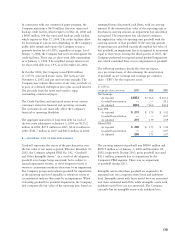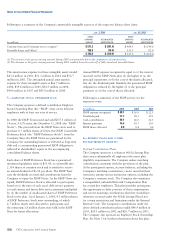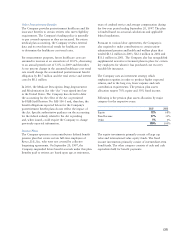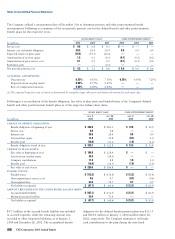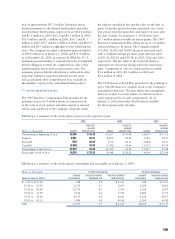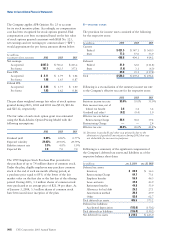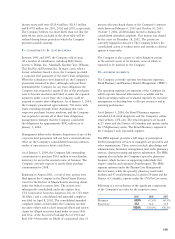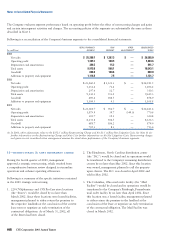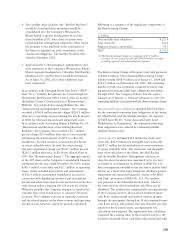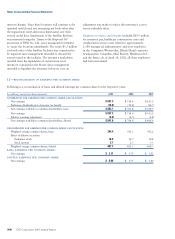CVS 2003 Annual Report Download - page 36
Download and view the complete annual report
Please find page 36 of the 2003 CVS annual report below. You can navigate through the pages in the report by either clicking on the pages listed below, or by using the keyword search tool below to find specific information within the annual report.
The Company adopted FASB Interpretation No. (“FIN”)
46, (revised December 2003), “Consolidation of Variable
Interest Entities,” effective December 24, 2003. This
interpretation addresses how a business should evaluate
controlling financial interest in an entity. FIN 46R replaces
FASB Interpretation No. 46. The adoption of this Statement
did not have a material impact on the Company’s
consolidated results of operations or financial position.
The Company adopted SFAS No. 150, “Accounting for
Certain Financial Instruments with Characteristics of
Both Liabilities and Equity,” effective June 15, 2003. This
Statement requires certain instruments previously classified
as equity on a company’s statement of financial position
now be classified as liabilities. The adoption of this
Statement did not have a material impact on the Company’s
consolidated results of operations or financial position.
The Company adopted SFAS No. 132, (revised 2003),
“Employer’s Disclosures about Pensions and Other
Postretirement Benefits,” effective December 15, 2003.
This Statement requires additional disclosures to those in
the original Statement 132 about the assets, obligations,
cash flows, and net periodic benefit cost of defined benefit
pension plans and other defined benefit postretirement
plans. The adoption of this Statement did not have a
material impact on the Company’s consolidated results
of operations or financial position.
2—LEASES
The Company leases most of its retail locations and
five of its distribution centers under noncancelable
operating leases, whose initial terms typically range from
15 to 25 years, along with options that permit renewals
for additional periods. The Company also leases certain
equipment and other assets under noncancelable operating
leases, whose initial terms typically range from 3 to 10
years. Minimum rent is expensed on a straight-line basis
over the term of the lease. In addition to minimum rental
payments, certain leases require additional payments based
on sales volume, as well as reimbursements for real estate
taxes, maintenance and insurance.
Following is a summary of the Company’s net rental
expense for operating leases for the respective years:
In millions 2003 2002 2001
Minimum rentals $ 838.4 $ 790.4 $ 758.2
Contingent rentals 62.0 65.6 67.6
900.4 856.0 825.8
Less: sublease income (10.1) (9.3) (9.1)
$ 890.3 $ 846.7 $ 816.7
Following is a summary of the future minimum lease payments
under capital and operating leases as of January 3, 2004:
CAPITAL OPERATING
In millions LEASES LEASES
2004 $ 0.2 $ 855.9
2005 0.2 816.3
2006 0.2 757.7
2007 0.2 704.5
2008 0.2 661.6
Thereafter 0.3 6,992.9
1.3 $ 10,788.9
Less: imputed interest (0.4)
Present value of capital lease obligations $ 0.9
The Company finances a portion of its store development
program through sale-leaseback transactions. The
properties are sold at net book value and the resulting
leases qualify and are accounted for as operating leases.
The Company does not have any retained or contingent
interests in the stores nor does the Company provide any
guarantees, other than a corporate level guarantee of lease
payments, in connection with the sale-leasebacks. Proceeds
from sale-leaseback transactions totaled $487.8 million in
2003, $448.8 million in 2002 and $323.3 million in 2001.
During 2001, the Company completed a sale-leaseback
transaction involving five of its distribution centers. The
distribution centers were sold at fair market value resulting
in a $35.5 million gain, which was deferred and is being
amortized to offset rent expense over the life of the new
operating leases. The operating leases that resulted from
these transactions are included in the above table.
3—BORROWING AND CREDIT AGREEMENTS
Following is a summary of the Company’s borrowings as of
the respective balance sheet dates:
In millions JAN. 3, 2004 DEC. 28, 2002
Commercial paper $— $ 4.8
5.5% senior notes due 2004 300.0 300.0
5.625% senior notes due 2006 300.0 300.0
3.875% senior notes due 2007 300.0 300.0
8.52% ESOP notes due 2008(1) 163.2 194.4
Mortgage notes payable 12.2 13.0
Capital lease obligations 0.9 0.9
1,076.3 1,113.1
Less:
Short-term debt —(4.8)
Current portion of long-term debt (323.2) (32.0)
$ 753.1 $ 1,076.3
(1) See Note 5 for further information about the Company’s
ESOP Plan.
Notes to Consolidated Financial Statements
(34) CVS Corporation 2003 Annual Report


